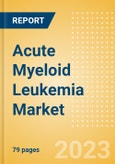Summary
This report covers the 8MM (US, France, Germany, Italy, Spain, UK, Japan, and China) and includes an assessment of the disease epidemiology and 10-year patient-based forecast (PBF) across the 8MM for marketed and late-stage pipeline therapies, with a launch date assessment by market for Acute Myeloid Leukemia (AML).These sales forecasts leverage data on pharmaceutical sales and drug availability from the author’s World Markets Healthcare (WMH) and POLI Price Intelligence databases.
This report includes an assessment of the disease epidemiology and 10-year patient-based forecast (PBF) across the 8MM for marketed and late-stage pipeline therapies, with a launch date assessment by market for Acute Myeloid Leukemia (AML). These sales forecasts leverage data on pharmaceutical sales and drug availability from the author’s World Markets Healthcare (WMH) and POLI Price Intelligence databases.
Acute myeloid (or myelogenous or myelocytic) leukemia (AML) is a malignancy of the hematopoietic system caused by abnormal proliferation or differentiation of myeloid progenitors in the bone marrow and peripheral blood. Despite being a rare blood cancer, AML is a blockbuster market and is expected to grow from sales of $2.3 billion in 2022 to $3.7 billion in 2032 at a compound annual growth rate (CAGR) of 3.7%. The current treatment paradigm for AML across the 8MM relies heavily on the use of Venclexta plus HMA or LDAC regimen for frail patients, and 7+3 chemotherapy for fit patients. There are several unmet needs in AML that call for more treatment options and improving transplant outcome for extending overall survival in patients.
Major drivers of growth in the AML market across the 8MM over the forecast period include the following:
- Approval of 14 new late-stage pipeline agents
- Pipeline agents to be used as therapies for improving HSCT outcomes are important market drivers as they create a brand-new market segment as HSCT aids
- Growing patient population to 2032
Major barriers to growth in the AML market across the 8MM over the forecast period include the following:
- Patent expiries and subsequent genericization of the most lucrative agents that are part of the standard of care, principally Roche/AbbVie’s Venclexta
- Limited launches of novel pipeline agents in Asian markets
- Continued dominance of the traditional 7+3 chemotherapy regimen in the newly-diagnosed setting
Key Highlights
- Report deliverables include a Pdf and Excel-based forecast model
- Forecasts includes the 8MM
- Forecasts covers from 2022-2032
. The publisher valued the Acute Myeloid Leukemia market in the 8MM at $2.3 billion and expects the market to increase to $3.7 billion by 2032
- Syndex Pharmaceuticals, Gamida Cell, and GlycoMimetics are expected to take market-leading position in 2032
- A high level of unmet need will remain for most Acute Myeloid Leukemia patient populations during the forecast period
- The AML late-stage R&D pipeline is diversified in addressing different pain points throughout the treatment journey
Scope
- Overview of Acute Myeloid Leukemia, including epidemiology, symptoms, diagnosis, and disease management.
- Annualized Acute Myeloid Leukemia therapeutics market revenue, cost of therapy per patient, and treatment usage patterns forecast from 2022 to 2032.
- Key topics covered include strategic competitor assessment, market characterization, unmet needs, clinical trial mapping, and implications of these factors for the Acute Myeloid Leukemia therapeutics market.
- Pipeline analysis: comprehensive data assessing emerging trends and mechanisms of action under development for Acute Myeloid Leukemia treatment. The most promising candidates in Phase III and Phase IIb development are profiled.
- Analysis of the current and future market competition in the global Acute Myeloid Leukemia therapeutics market. Insightful review of the key industry drivers, restraints and challenges. Each trend is independently researched to provide qualitative analysis of its implications
Reasons to Buy
- Develop and design your in-licensing and out-licensing strategies through a review of pipeline products and technologies, and by identifying the companies with the most robust pipeline.
- Develop business strategies by understanding the trends shaping and driving the global Acute Myeloid Leukemia therapeutics market.
- Drive revenues by understanding the key trends, innovative products and technologies, market segments, and companies likely to impact the global Acute Myeloid Leukemia therapeutics market in the future.
- Formulate effective sales and marketing strategies by understanding the competitive landscape and by analyzing the performance of various competitors.
- Identify emerging players with potentially strong product portfolios and create effective counter-strategies to gain a competitive advantage.
- Organize your sales and marketing efforts by identifying the market categories and segments that present maximum opportunities for consolidations, investments and strategic partnerships
Table of Contents
Companies Mentioned (Partial List)
A selection of companies mentioned in this report includes, but is not limited to:
- Abbvie
- Actinium Pharmaceuticals
- Astellas Pharma
- Astex Pharmaceuticals
- Arog Pharmaceuticals
- Bristol Myers Squibb
- Celgene
- CSPC Pharmaceutical Group
- Daiichi Sankyo
- Delta-fly Pharma
- Gamida Cell
- Gilead Sciences
- GlycoMimetics
- Jazz Pharmaceutcials
- Kura Oncology
- Novartis
- Orca Biosystems
- Pfizer
- Priothera
- Rigel Pharmaceuticals
- SELLAS Life Sciences Group
- Servier Pharmaceuticals
- Sunshine Lake Pharma
- Syndax Pharmaceuticals
- TC BioPharm








